Paul Bocuse, the giant of French and world cuisine, has died. Here’s a list of the most important moments and statements in his amazing career
- The only son of George and Irma, Paul Bocuse was born in 1926 in Collonges-au-Mont-d’Or, a few kilometres from Lyon. On February 11th he would have turned 92.
- The epigone in a dynasty of cooks that first started in the 17th century, he first wore toque and apron at 16, in the middle of World War II, next to Claude Maret, chef at restaurant Soierie in Lyon. He soon joined the French army as a volunteer. He got a glancing bullet wound in Alsace and was treated by the Americans in the United States.
- His first masters include an important woman, Eugénie Brazier (1895-1977), La Mère Brazier, the mother of modern French cuisine. She’s the very first chef (male or female, it doesn’t matter) to get 3 Michelin stars in two restaurants at the same time: Rue Royale in Lyon and Col de la Luère in Luère. Bocuse arrives as a commis in the restaurant in the Alps. This is how he remembered her: «She was a strong and modest woman. She knew how to select the men and best products for her restaurant». A lesson he learnt from her.
- His training continued at the legendary Lucas Carton restaurant in Paris. Richard Gaston is the chef and the kitchen brigade includes Jean Pierre Troisgros, another pillar in French cuisine and an old friend of Monsieur Paul. In 1950 he goes to La Pyramide in Vienne, near Lyon, under the wing of master Fernand Point.
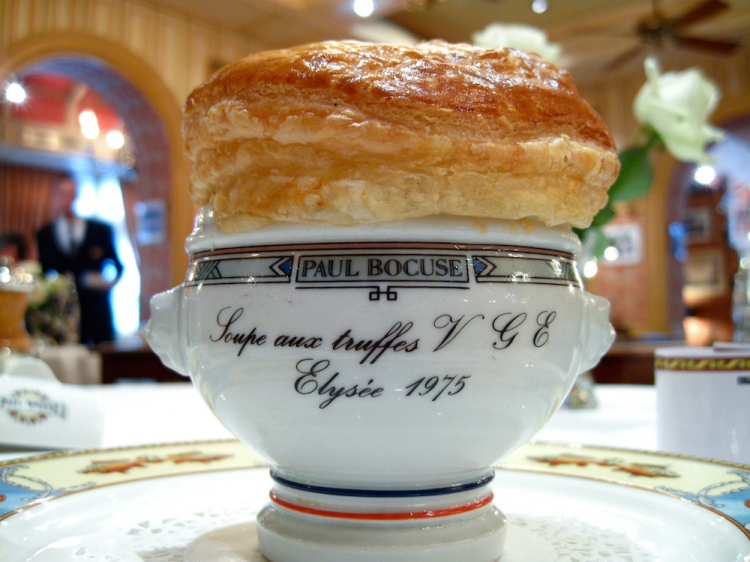
The famous Soupe aux truffes VGE
- In 1961 he’s MOF (
Meilleur Ouvrier de France), a title that he said was the one that gave him the greatest joy. The same year he gets the first Michelin star. The highest prize from the Red Guide arrives in 1965, after the first (1961) and the second star (1962). No other restaurant in the world has had three Michelin stars for 52 years in a row.
- In 1975 he received the Légion d’honneur, the highest acknowledgement given by the French Republic. When he receives the letter signed by president Valéry Giscard d’Estaing he thinks it’s some kind of joke from a friend. That same year, so as to celebrate the occasion, he creates what is still his most famous dish, Soupe aux truffes VGE (the latter are the president’s initials). The original recipe? After breaking the puff pastry at the top, you can find a quarter of a litre of concentrated chicken stock, 20 grams of foie gras, truffles from Perigord, mushrooms cooked at length in butter.
- In 1989, the guide of French journalists Henri Gault and Christian Millau, who signed the manifesto of nouvelle cuisine, nominate Bocuse as the “Chef of the Century”. A title he received 22 years later too, from the prestigious Culinary Institute of America.
- In the following decades he opened 9 restaurants and brasseries in Lyon and the surroundings, such as Le Nord, l'Est, Le Sud and l'Ouest. He bought a plot in Beaujolais, and became a great collector. He also completed countless consultancy projects in Japan, the United States and Switzerland.
- His dishes that went down in history include Duck with foie gras and pistachio, Bresse chicken fricassee with cream and morels, Duck foie gras in a gelatine of Porto in the style of Antoine Carême, French style Maine lobster salad, Sea bass filet with spaghetti à la Fernand Point, Mullet with crispy potato chips, Le President Maurice Bernachon cake. These recipes have strong hints at historic French fine dining, at the bourgeoisie and the institutions. Complex and strong dishes, rich in calories.
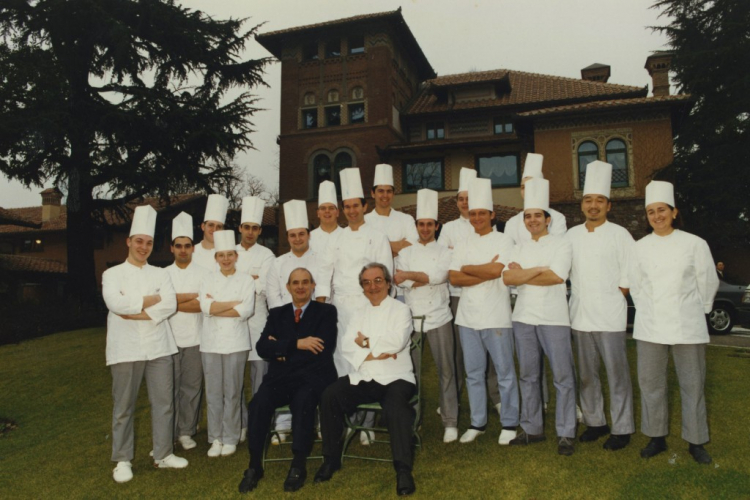
Paul Bocuse and Gualtiero Marchesi in a photo from 1995, at Albereta in Erbusco. Two giants who passed away in a matter of a few weeks (photo from artasersepasqual.com)
- Speaking of digesting a meal, these words of his became famous: «If you want to feel good, go to a doctor». The implication: «Don’t come to my restaurant, I’m not interested in your digestion». It was a clear violation of the principles of Nouvelle Cuisine which, in a list from 1973 required light preparations and substituting fat and heavy sauces with lighter and easier to digest ones.
Bocuse was one of the promoters of the manifesto, but had a conflicting relationship with the movement. He was too famous to fully take sides with a philosophy of which he shared the principles.
- His style of cuisine? «Unchangeable», said critic
Par Thibaut Danancher, «A perfect match between cream, butter and wine», a triptych that was already dear, over a century ago, to
Georges Auguste Escoffier, who catalogued French and world fine dining. «Why should I change a winning philosophy?»,
Bocuse always said, allergic to any fashion. And he added the famous sentence: «I believe there’s only one cuisine: good cuisine».
- Vegetarianism? Never: «Every respectable meal should always end with meat». Molecular? «Certainly not».
- French to the bone: «Our country is a huge fish tank defined by the Mediterranean Sea and the Atlantic Ocean, with a gigantic chicken farm in Bresse, and cattle in Charolais. From north to south we have have endless orchards, an unmatchable terroir and in the vineyards one can find the best of our ambassadors. No other country has this luck». Until two years ago, his menus were only available in his mother tongue.
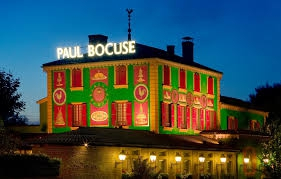
His restaurant in the suburbs of Lyon, 3 uninterrupted Michelin stars for 52 years
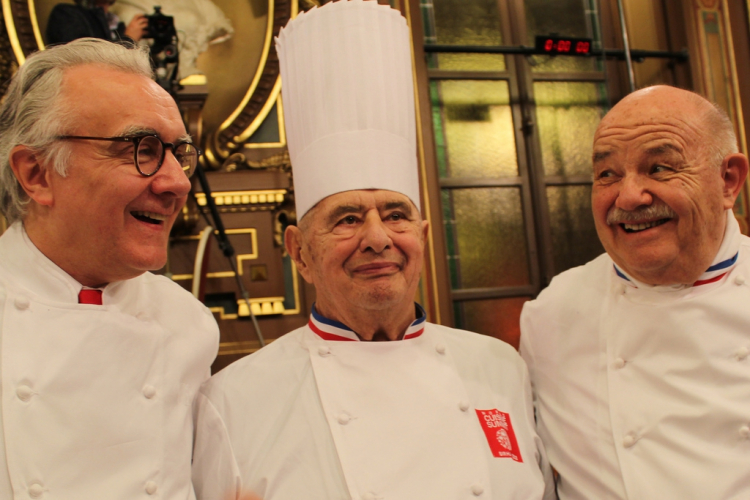
Between Alain Ducasse and Pierre Troisgros
- A statement that later denied another famous quote of his: «The hegemony of French cuisine will last until Italian chefs won’t realise the huge heritage on which they’re sitting».
- His passion for women was also notorious. Three were his “official” partners, even at the same time, in what was defined as
Bocuse’s trigamy. These were much more than clandestine affairs. He met
Raymonde before the war, a young blond girl of 16. She held the reins of the restaurant for many years. In 1946 their daughter
Françoise was born. In 1969 he started a relationship with hospital director
Raymone, who gave birth to their son, chef
Jérôme Bocuse, who has been managing the family empire for a few years now. The third woman is
Patricia, whom he met only two years after
Raymone. There’s a famous quote he told their daughter
Ève-Marie, who curated Bocuse’s biography: «If I count the number of years in which I was faithful to the three women I met on my way, I reach 135 years of shared life». He also added, recently: «I have no regrets, except for the pain I caused to my women. I hope they will forgive me».
- He loved sharing his profession with young people. This is why legions of cooks chose his school at Institut d’Écully. This is why he founded the Bocuse d’Or, now the most famous contest between chefs from different nationalities, first edition in 1987: «I’m very happy», he said, «that today many small Bocuses have become great cooks. It’s my greatest joy».
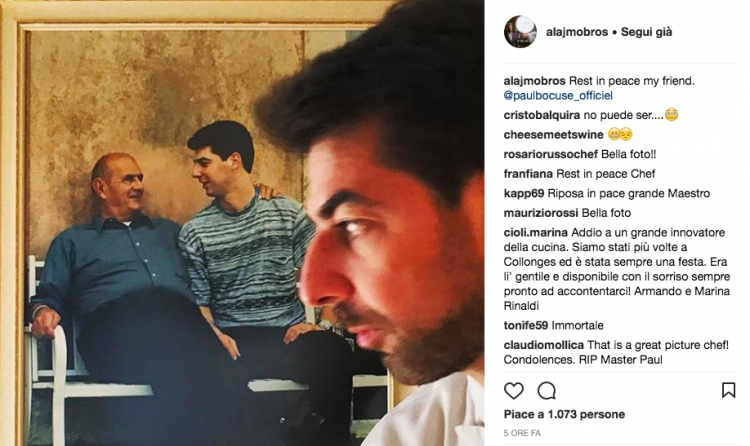
Massimiliano Alajmo’s farewell on Instagram. Bocuse visited Le Calandre only a few weeks ago
- The pupils and colleagues who worked beside him are the Gotha of the French (and not just French) restaurant scene. Just to name a few:
Alain Chapel,
René Lasserre,
Pierre Laporte,
Gaston Lenôtre,
Georges Blanc,
Marc Veyrat,
Roger Verger,
Jean Troisgros,
Pierre Troisgros,
Raymond Oliver,
PaulHaeberlien and
Michel Guerard.
- In recent years many have considered the
Auberge du Pont de Collonges as a not-to-be-missed stop, in order to understand the history of French haute cuisine in just one meal. On the other hand, it has been criticised because of its immovable menu and the fact it ignores contemporary ideas.
- As soon as he learnt of his death, friend and chef from Lyon Christophe Marguin, interviewed by Le Progrès, said without mincing words: «God has died». The farewells from young and old chefs are flooding social networks.
- He’d been sick for some time now, but he never stopped greeting guests at each table. He used to say: «When I drive the bus of life and look back, I see many friends have already left. Sooner or later I’ll join them».
Translated into English by Slawka G. Scarso